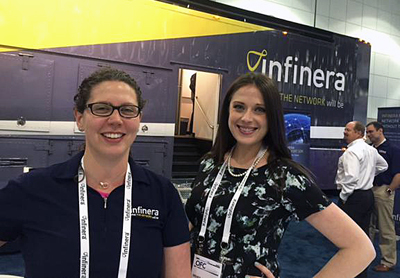25 Mar 2015
Scale and virtualization are driving technological change in optical network architectures.
In optical communications networks, the emergence of layers C and T (Cloud and transport) at a time when Cloud services are growing quickly and high-capacity connectivity is more important than ever, means that service providers need to be able to scale and increase the flexibility of their infrastructure.So-called Network Function Virtualization (NFV) provides one means of addressing these needs for the upper layers of an optical network through the migration of network functions from dedicated appliances to software services on "x86 hardware" within Cloud data centers.
Acknowledging this, Infinera, a developer of “intelligent” optical transport networks has this week at OFC 2015, introduced two photonic integrated circuits to support transport applications as “scale and virtualization are driving change in network architectures”. The new PICs include the sliceable, enhanced ePIC-500 and the application-optimized oPIC-100.
The Cloud services layer supports NFV plus other Cloud-delivered services in Layer C. In order to support Layer C, Cloud data centers and end users need to be interconnected by a scalable and flexible transport network: Layer T. PICs are integral to the evolution of the transport network providing significant benefits when integrated into a packet-optical DWDM transport system for an efficient Layer T, ultimately allowing Layer C to thrive.
Infinera's "sliceable" photonics technology is claimed to provide "a large pool of capacity" in a PIC that can be divided at a granular optical level with each slice capable of being routed in a different direction as it exits the line card or the system housing it, usually at the hub.
The recipient of the individual slice is a line card or system that matches the capacity, usually at the "spoke" of the network. The ePIC-500 provides sliceable 500G capacity at the hub location, while the new oPIC-100 provides 100G capacity at the spoke location. While these two new PICs are applicable across all network locations they were developed specifically to support Layer T in the metro.

New kit: Infinera's roadshow at OFC 2015.
Infinera says it modeled a range of applications from metro aggregation to regional long-haul links, where hub-and-spoke, mesh or ring topologies are common. With the new PICs, the models showed an estimated average reduction of 28% in modules, 31% in power and 45% in bandwidth inefficiencies when compared with conventional off-the-shelf systems based on single-wavelength or super-channel solutions for 100G, 200G or 400G.
Juan Pedro Fernández-Palacios, Senior Manager at Telefonica, commented, "We find the Infinera sliceable photonics technology to be very relevant for network architectures and have already tested this in our lab," said . "As Cloud services take off, it is imperative that transport networks be scalable yet granular and simple to operate. Enhancing the super-channel technology with slice-ability is the right approach to satisfy these needs simultaneously."
"Infinera continues to leverage its expertise in photonics to provide operators tools to build optimized Transport Layer infrastructure," said Rick Talbot, principal analyst at Current Analysis. "We view sliceable photonics provided by the ePIC-500 and oPIC-100 as a significant step in providing flexible wavelength granularity for super-channels, allowing operators to lower the costs and complexities of transport while handling enormous traffic growth."
"Infinera has been shipping PICs in transport systems, that have been designed from the ground-up, for over a decade," said Dave Welch, co-founder and president at Infinera. "During this time the technology has surpassed over 1.5 billion hours of field operations. Sliceable photonics allows our customers to build networks with scale and flexibility for a wide variety of applications ranging from the metro to the long-haul. It provides a comprehensive tool set for us to be nimble and build market-specific platforms for Layer T as our customers' needs continue to evolve."
About the Author
Matthew Peach is a contributing editor to optics.org.
| © 2025 SPIE Europe |
|